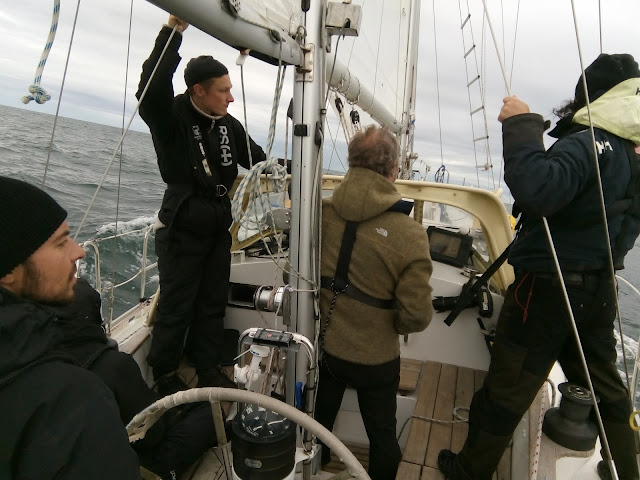The
first season of Greenland Halibut fishery ended on Wednesday (14/6)
and we are now looking at the results and preparing for the next
season, which starts 31/7.
We
battled with weather (rough seas) that limited the opportunities of
working with the acoustic gear and surprisingly with sperm whales
that seemed to have lost interest in the line fishery.
Unlike
previous seasons, the depredation events were concentrated on the
first week of fishery.
We
heard and saw sperm whales on the fishing grounds, but to our great
surprise they were not interested on the lines. We observed twice
whales that clearly “investigated” all five vessels hauling in
their lines, but instead of approaching they travelled away. Similar
events were also reported by the fishermen.
Fishing in the midnight sun.
We are trying to figure out what this was about.
One possibility is that these were individuals that had not learned
the technique yet, and the individuals we have observed before were
somewhere else. This seems a bit unlikely since the whales clearly
came towards the boats. Young fishermen Erik, who participated in the
field work onboard Iolaire, pointed out that the Greenland Halibut
was much smaller than in the beginning of the season. We have now
interviewed the skippers who saw depredation and they all say that
this happened when they had large fish on the lines. It is rather
amazing if it indeed turns out that the whales only come to the lines
if the fish is large enough. Luckily this kind of data is available,
also for the catches from previous seasons, and we will look into
this in more detail. This approach will add to our understanding of
the behavior and potential mitigation measures.
Fisherman
Arto Laukkanen took excellent footage of the sperm whale they saw on
the first day of fishery, 22/5. This individual was not identified
last season, and is now added to the catalogue of known individuals
depredating on the lines. The same boat observed three sperm whales a
few days later, something that was recorded last year as well. One
very large male and two smaller ones. We hope to see these whales in
August and identify them. We know very little of the social structure
of the male sperm whales in these waters. In literature they are
described as solitary, however this observation as well as others
from winter season (when groups of more than 10 males have been seen)
give a more complex picture.
Iolaire under way.
The
towed hydrophone array (courtesy of Vanishing Point Marine ) worked very well
and we hope to be able to record depredation events in August. We
have some really good sound recordings of sperm whales and also of
the sound of the fishing fleet hauling in the lines – last year
these sounds seemed to alert the whales to the fishing activity.




















